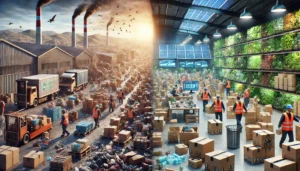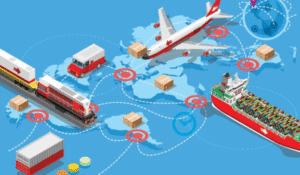INTRODUCTION: The New Development Paradigm
For too long, development has focused on GDP, infrastructure, and industrial growth often at the expense of nature, public health, and social equity. The result? A world facing climate breakdown, burnout, and deepening inequality.
It’s clear: the old models are no longer working.
What’s emerging instead is a holistic approach, one that weaves together environmental health, human well-being, and sustainable trade as inseparable elements of true progress. It’s not about sacrificing profit for the planet or wellness for growth, it’s about designing systems where all three thrive together.
In this blog, we’ll explore how this integrated model is reshaping everything from business practices to land use planning. We’ll look at real-world strategies, global frameworks, and inspiring leaders like Taraka International, a company proving that sustainability and success can go hand in hand.
A new path is possible and it begins by seeing the connections.
SECTION 1: The Interconnected Web Why Holistic Matters
1.1 Moving Beyond Silos
Development has often been treated like a checklist: grow the economy, then worry about the environment, and later, perhaps, address social well-being. In reality, these pillars do not stand alone. Ignoring their interdependence leads to unintended consequences. Economic booms can deplete ecosystems. Infrastructure projects may marginalize communities. Growth that overlooks health and wellness often creates long-term instability.
Take deforestation, for example. On the surface, it may seem like an economic decision. In practice, it disrupts water systems, increases disease risk, and weakens the livelihoods of nearby communities. Or consider a city designed without green space. Productivity might increase, but so do rates of stress, anxiety, and respiratory illness.
When progress is compartmentalized, the result is fragility. A holistic approach encourages us to recognize the connections and design solutions that reflect them.
1.2 Systems That Feed Each Other
Everything is connected. Economic activity depends on natural resources. Healthy ecosystems support human well-being. Communities that are mentally, physically, and socially healthy are more resilient, creative, and productive.
These are not abstract ideals. They are measurable and economically grounded realities.
For example, sustainable land use planning can lower healthcare costs, improve food security, and strengthen local economies. When land is managed to protect biodiversity and water sources, the people who live nearby benefit in multiple ways.
This kind of systems thinking is at the core of Taraka International’s operations. Sustainability is not an afterthought; it is integrated throughout the organization. From regenerative sourcing to wellness initiatives in partner communities, Taraka demonstrates that environmental health, social equity, and business performance can function as a single, reinforcing system.
The takeaway is simple. When development efforts are rooted in connection, we do more than solve problems. We prevent them and often turn them into opportunities.
SECTION 2: Nature as the Foundation of Prosperity
2.1 Natural Capital Powers the Economy
Nature is not just a backdrop to development. It is a key driver of it. Over half of the world’s GDP depends on the services nature provides, from clean water and fertile soil to pollination, climate regulation, and raw materials. These benefits are often taken for granted, but without them, industries collapse, supply chains weaken, and communities suffer.
Forests, wetlands, oceans, and other ecosystems offer more than scenic beauty. They are essential infrastructure. When ecosystems are damaged, the costs show up in health systems, agriculture, disaster recovery, and economic output. For example, degraded watersheds increase the cost of drinking water treatment. Deforestation can lead to soil erosion, reducing agricultural productivity and threatening food security.
Investing in nature is not a cost. It is a return-generating strategy.
2.2 Restoration as Resilience
Protecting and restoring ecosystems leads to tangible benefits for people, businesses, and governments. Reforestation projects, wetland conservation, and regenerative agriculture are not only good for biodiversity, but they also create jobs, support livelihoods, and make regions more resilient to climate impacts.
Taraka International understands this value deeply. In regions where it operates, the company prioritizes nature-positive sourcing practices that rebuild soil health, preserve water resources, and support biodiversity. By protecting the natural systems their business depends on, Taraka helps ensure long-term viability for both people and the planet.
Nature is not a resource to be extracted endlessly. It is a foundation to be nurtured, regenerated, and integrated into every decision. When development strategies put nature first, prosperity follows.
SECTION 3: Wellness Beyond Medicine
3.1 Redefining Well-Being
Health is often viewed through a narrow lens of hospitals, medicine, and disease treatment. But true wellness includes much more. Physical, mental, emotional, and even spiritual well-being all contribute to a thriving society. This broader view recognizes that where and how people live affects how well they live.
Access to clean air, green spaces, traditional healing practices, and time spent in nature all contribute to better health outcomes. Research consistently shows that time outdoors can lower stress, improve immunity, and support emotional balance. Communities that prioritize these aspects of wellness tend to be healthier, more connected, and more productive.
Green design in cities, walking trails, community gardens, and the use of natural building materials are not luxuries. They are essential parts of a development model that supports long-term well-being.
3.2 Wellness as a Business Strategy
Organizations that invest in employee wellness are seeing measurable returns. Reduced absenteeism, higher engagement, and improved productivity are just some of the benefits. But this isn’t just about yoga classes or occasional perks. It’s about creating environments where people can thrive every day.
Taraka International builds wellness into its business model. From providing access to local, organic food to creating partnerships with local health practitioners and environmental educators, the company ensures that well-being is part of both its internal culture and its community engagement. These efforts reflect a deeper belief that people and planet flourish together.
When wellness is prioritized not as a trend but as a strategy everyone benefits. It builds healthier individuals, stronger teams, and more resilient communities.
SECTION 4: Trade That Regenerates, Not Depletes
4.1 Rethinking Trade as a Tool for Sustainability
Trade has often been viewed as a driver of growth at any cost. But in today’s world, the cost of unchecked trade is becoming too high. Unsustainable production methods, overextraction of natural resources, and unfair labor practices can damage ecosystems and communities alike.
A new model is emerging that uses trade to regenerate rather than deplete. Nature-positive trade involves sourcing, production, and distribution practices that restore ecosystems and respect human rights. This includes everything from agroforestry and sustainable fisheries to eco-certified products and supply chains that prioritize local livelihoods.
Governments and businesses are beginning to align trade policies with environmental and social goals. Sustainable trade agreements, fair labor standards, and biodiversity-focused regulations are all part of this shift.
4.2 Business Innovation and Global Examples
Companies that embrace nature-positive trade are not just avoiding harm. They are gaining market access, improving risk management, and building stronger brands. Regenerative agriculture, clean energy sourcing, and transparent supply chains are becoming key to staying competitive.
Taraka International is part of this global transition. Its supply chain prioritizes traceability and local partnerships, supporting small producers who follow sustainable practices. The company also invests in community-led restoration projects that not only protect the environment but create shared economic value.
This model proves that trade and sustainability are not opposites. In fact, when designed thoughtfully, trade can be one of the most powerful tools we have for building a healthier planet and a fairer global economy.
SECTION 5: Practical Benefits in Action
5.1 Corporate Examples Leading the Way
Many companies are proving that integrating nature, wellness, and sustainability is not just good ethics, it’s good business. Leaders like Patagonia, IKEA, and Seventh Generation are embedding eco-conscious practices into everything from sourcing to employee care.
These businesses offer organic food in their cafeterias, support mindfulness and wellness programs, reduce waste, and prioritize renewable energy. They show that sustainable operations and workforce well-being can go hand in hand.
Taraka International is part of this growing movement. The company integrates sustainability not only in its sourcing but also in its organizational culture. Wellness programs for employees, investment in green infrastructure, and regenerative practices across its supply chains are just a few examples. These actions are not for branding; they are strategic decisions that drive innovation, retention, and long-term value.
5.2 Measurable Impacts
Nature-positive and wellness-driven strategies are delivering tangible outcomes. Businesses report lower operational risks, better employee performance, and increased customer loyalty. Communities experience improved health, greater economic stability, and restored ecosystems.
Taraka’s investment in local wellness initiatives, such as nature-based education and access to green public spaces, has created lasting community partnerships. In some regions, this has helped reduce health service burdens and improved local food security. These are not isolated wins; they reflect the power of systems designed with long-term value in mind.
The message is clear. When nature, wellness, and sustainable trade are integrated thoughtfully, everyone benefits from shareholders to schoolchildren.
SECTION 6: Cooperation Across Sectors
6.1 Collective Action for Collective Impact
No single sector can solve complex development challenges alone. The issues we face climate change, public health crises, biodiversity loss, economic inequality are interconnected, and so are the solutions. That’s why collaboration is essential.
Governments, businesses, NGOs, indigenous communities, and academic institutions each bring unique knowledge and influence. When they work together, the results are more innovative, inclusive, and resilient. Co-designed policies, community-led conservation, and public-private sustainability programs are showing that shared leadership leads to deeper impact.
Frameworks like the Kunming-Montreal Global Biodiversity Framework and nature-positive trade initiatives offer roadmaps for how sectors can align strategies for global benefit.
6.2 Taraka International’s Collaborative Model
Taraka International actively invests in partnerships that blend traditional ecological knowledge with modern science. In regions where it operates, the company works with indigenous communities, local farmers, wellness practitioners, and environmental NGOs to co-create initiatives that regenerate land, support livelihoods, and strengthen community health.
By listening first and acting collaboratively, Taraka helps build solutions that last not because they are imposed, but because they are rooted in shared ownership.
This kind of cooperation is not just admirable. It’s necessary. Sustainable development demands diverse voices at the table, united by a common goal: to build systems that nourish people, protect the planet, and support future generations.
SECTION 7: Building with Systems Thinking
7.1 From Fragmented Fixes to Integrated Solutions
Traditional approaches to development often focus on isolated problems: clean water here, economic growth there, healthcare somewhere else. While well-intentioned, this piecemeal mindset rarely addresses the deeper patterns that cause systems to break down in the first place.
Systems thinking changes the approach. It looks at the whole how different elements interact, how feedback loops form, and how one change can ripple through an entire community or ecosystem. It’s about designing development strategies that reinforce each other, rather than compete for attention or resources.
For example, integrated land use planning brings agriculture, conservation, housing, and infrastructure into one conversation. This kind of coordination can restore degraded areas, improve food and water security, and ensure more equitable economic opportunities for local populations.
7.2 Measurement, Transparency, and Accountability
To manage complex systems, we need clear, science-based goals and the tools to track them. Transparent reporting, adaptive learning, and regular monitoring help ensure that progress is not just promised, but delivered.
Many forward-thinking companies are already using impact dashboards, biodiversity risk assessments, and well-being metrics to inform their strategies. Taraka International, for instance, incorporates environmental and wellness indicators into its core business reviews. By measuring soil health, employee well-being, and supply chain equity, the company can identify where to improve and where to scale.
Accountability builds trust. It also strengthens outcomes by encouraging reflection, adjustment, and innovation.
CONCLUSION: A New Blueprint for Development
The path forward is clear. Integrating nature, wellness, and sustainable trade is not a luxury, it is a necessity for a world facing ecological collapse, health crises, and economic inequality. A holistic approach acknowledges that these issues are not separate. They are deeply connected, and so must be our solutions.
By moving beyond silos, embracing systems thinking, and fostering cross-sector collaboration, we can build development models that are not only more ethical but more effective. Models that heal ecosystems, empower communities, and create lasting prosperity.
Taraka International is one of many organizations proving that this vision is not abstract. It’s real, it’s actionable, and it’s already underway. Their work shows that when we design for interconnection, we unlock potential in people, in nature, and in business.
We all have a role to play. Whether you are a policymaker, entrepreneur, educator, or community member, the opportunity is the same: to help shape a world where development means thriving ecosystems, healthy people, and fair, sustainable economies.
It is time to stop choosing between growth and well-being. We can have both if we choose to build differently.
FAQs
1. What is Taraka International’s mission?
Taraka International is committed to advancing a holistic model of development that integrates environmental sustainability, human wellness, and ethical trade. The company believes that long-term prosperity comes from aligning business success with the health of communities and the planet.
2. How does Taraka International practice sustainability?
Sustainability is embedded into every layer of Taraka’s operations. This includes regenerative agriculture, nature-positive sourcing, low-impact manufacturing, and investments in ecosystem restoration. Taraka also works with local and indigenous communities to ensure that environmental goals support cultural and economic resilience.
3. What wellness initiatives does the company support?
Taraka runs a range of wellness programs internally and externally from employee mindfulness and movement initiatives to partnerships that create access to green spaces, clean water, and nutrition education in local communities. The company views wellness not just as a benefit but as a strategic pillar of development.
4. Where does Taraka International operate?
Taraka works across several regions in Asia, Africa, and Latin America, focusing on areas where development, biodiversity, and community health intersect. Its work is grounded in local collaboration, with initiatives tailored to each region’s ecological and cultural context.
5. How can businesses or communities partner with Taraka International?
Taraka welcomes partnerships with purpose-driven organizations, governments, and community groups. Whether through co-developing sustainable supply chains, launching wellness initiatives, or supporting land restoration, Taraka seeks collaborations that align with its values and amplify positive impact.




